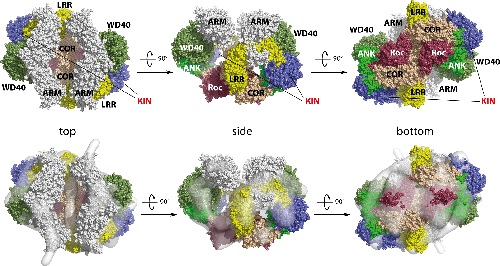Parkinson protein shape revealed
An international group of scientists working in a consortium sponsored by the Michael J. Fox Foundation (MJFF) has published a model of the ‘Parkinson protein’ LRRK2. This opens the way to understanding why mutations to this protein can cause the disease. University of Groningen biochemist Arjan Kortholt is one of the corresponding authors of the paper which describes the model. It was published on 28 June in Proceedings of the National Academy of Sciences .
In Kortholt’s absence, his colleague Peter van Haastert (who was not involved in the paper but worked on the Parkinson project until a few years ago) explains the new findings. ‘The authors combined several different techniques to generate the model. It is very impressive work.’ Mutations in the LRRK2 protein have already been found to cause Parkinson’s disease, in which dopamine-producing cells in the brain die. ‘Exactly why this is, we don’t know. Knowing the protein structure will help solve this question.’

LRRK2 is a large protein, and on top of that, it is present as a dimer (two copies of the protein which are bound together). ‘It’s made up of a large number of different domains, and parts of the protein are very flexible’, explains Van Haastert. This makes it difficult to establish its structure. The classical way to determine the 3D structure of a protein is to grow crystals of it for X-ray crystallography. The size and mobility of LRRK2 make this impossible.
‘But we have made crystals from several domains’, says Van Haastert. ‘And we studied structures from much smaller bacterial analogues of LRRK2, the ROCO proteins.’ Furthermore, a low resolution electron microscopy ‘picture’ of the protein is available. ‘That doesn’t show much detail, but you can see “blobs”. In this new paper, the known structures were correlated with these blobs.’ Finally, studies were done to see which parts of the protein were in contact with each other.
The final result was presented in a paper published by the journal Proceedings of the National Academy of Sciences. It is a landmark study for those interested in Parkinson’s disease. ‘The structure is an important step in understanding the role of LRRK2 in this disease.’

Previous work by Van Haastert and Kortholt has shown that a Parkinson-causing mutation makes the protein overactive. LRRK2 is a kinase, an enzyme which catalyzes the transfer of phosphate groups from high-energy, phosphate-donating molecules to specific substrates. ‘But we don’t know why this causes the dopamine-producing cells in the brain to die.’ Experiments with specific kinase inhibitors failed because they caused kidney problems. ‘The protein is also expressed in the kidneys. But if it is overactive, it doesn’t cause any problems there; it is only when it is inhibited.’ And of course, there’s the question of why a person with a mutation in LRRK2 is healthy for forty to fifty years, before the Parkinson symptoms begin.
Arjan Kortholt has recently been awarded €500,000 by the MJFF to continue his research. He is heading an international research team that aims to extend the structural work on LRRK2. They want to find out which domains are in contact with each other, what this tells us about the function, and how we can use it to treat LRRK2-mediated Parkinson’s disease. The new structure is a big step forward, but the road to understanding and treating Parkinson’s disease will be a long one.
Reference: Giambattista Guaitolia et al.: The structural model of the dimeric Parkinson’s Protein LRRK2 reveals a highly compact folding involving distant domain-domain contacts. PNAS 28 June DOI 10.1073/pnas.1523708113
| Last modified: | 19 September 2017 12.47 p.m. |
More news
-
16 April 2024
UG signs Barcelona Declaration on Open Research Information
In a significant stride toward advancing responsible research assessment and open science, the University of Groningen has officially signed the Barcelona Declaration on Open Research Information.
-
02 April 2024
Flying on wood dust
Every two weeks, UG Makers puts the spotlight on a researcher who has created something tangible, ranging from homemade measuring equipment for academic research to small or larger products that can change our daily lives. That is how UG...
-
18 March 2024
VentureLab North helps researchers to develop succesful startups
It has happened to many researchers. While working, you suddenly ask yourself: would this not be incredibly useful for people outside of my own research discipline? There are many ways to share the results of your research. For example, think of a...

